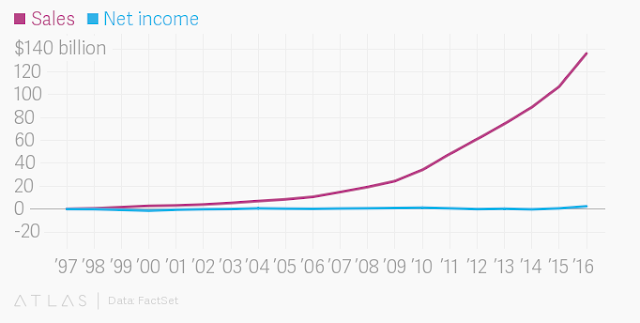AMAZON: WHEN A COMPANY BECOMES A PLATFORM
What is Amazon? How would you
define Jeff Bezos’ company that was founded in 1994?
It is common view to define Amazon
as an online retailer and cloud computing services' company which is heavily investing in
increasing the effectiveness of its logistical processes. For Amazon, logistics
has become the core of its business: it manages the supply chain from supplier
out through a distribution system to the final user. In doing so, Amazon is
able to establish a competitive advantage through a superior customer service
that is eventually the outcome of flexibility, quickness of delivery and
real-time implementation of its inventory system.
Simply put, cloud-computing
inventory and net-centric supply system helped Amazon to obtain the cost
advantages typical of economies of scale: the physical logistics and the
e-commerce platform get together to give Amazon full information dominance and
situational awareness of the market, therefore minimizing overstocking,
understocking and avoiding overhead costs in terms of up-front IT
infrastructure costs.
However, for the scope of this
short script, the main aim is not to figure which kind of business organization
Amazon is. No, what matters is to understand how the real value of this company
is measured. For Damodaran, from the outset Bezos
has been very clear in setting out his real objectives: rather than maximizing
the current value per share of existing stock, Bezos “flywheel” philosophy aimed to attract as
many customers as possible through an aggressive pricing strategy. Regardless
shareholders, profits and earnings. Indeed, Amazon at the beginning generated few revenues with high operating
losses
and the Seattle-headquartered company barely broke even. Notwithstanding losses
and poor quarterly earnings on its income statements, the market capitalization
kept growing and reached $35 billion in early 2000. Today Amazon’s worth $648.51 billions.
Market capitalization is by
definition the value of the company calculated by multiplying company’s shares
outstanding by its current market price. If we look at the EBITDA and the operating profit margin of the company
over the last few years, Amazon seems to have stagnated. As a consequence, or
at least as its book value should suggest, shares of Amazon should’ve behaved
accordingly. However, as stated earlier, its valuation by the market has
skyrocketed: market value is now worth more than 250 times its earnings. As
simple as corporate finance’s valuation theory suggests, Amazon’s
value reflects nothing but expected future cash flow and its underlying assets:
thus, Amazon’s current valuation of its shares reflects the future growth in terms of
profitability. However, many have contended that a company worth 250 its earnings is
a gamble, similar to a bubble ready to burst.
So, what? How’s it possible that
Wall Street mostly disregard Amazon’s meagre quarterly earnings? Where does the
secret of such share growth price lie? Is the market so irrational to overprice
a company with few operating margins? Or is Amazon just another example of the
equity premium vis-à-vis the decline in the real return of fixed-income-assets?
It’s worth noticing how Amazon has never paid dividends: that was quite
comprehensive after 2000’s dot-com bubble-when NASDAQ listed companies used to
raise as much surplus cash as possible to shield against possible fallouts and
take advantage of growth opportunities- but today Bezos’ creature is a cash
generating machine which is punching above its weight, sprawling well beyond
its ecological niche. So, if the fundamental sources of stock valuation rests
on the earnings and dividends of firms,
how can a company that has never paid dividends be worth like Amazon?
The bottom line is that stocks have value because of the appreciation of
cash flows investors hope to receive: thus, the value of any asset is determined by the
discounted value of all expected future cash flows. In
this sense, Amazon’s weighted average cost of capital- the rate used in
corporate finance to evaluate the return asked by security holders, both debt
and equity, to raise money- is around 9%, and it ROIC-the return on the capital
invested both by equity and debt holders- is around 6%. Therefore, Amazon’s
index of profitability is meager with respect
to its peers.
However, the rationale behind the market
capitalization of Bezos’ company is pretty simple: Amazon is a logistic platform that is expanding
well beyond its ecological niche. Since 2000 it has been heavily investing its
huge amount of surplus cash in new capital projects such as cloud computing services,
artificial intelligence, grocery stores and other new businesses which are
forecasted to offer high returns.
Overall, Amazon is not just
e-commerce and retail, and is much more than transportation and logistics. It
has become a platform encompassing AI, media and publishing, cloud computing,
hardware and devices, grocery stores and traditional delivery service. Not to
mention other businesses such as financial technology and banking
services. This platform rests on a
meta-system of extraordinary complexity made up of a near-perfect intelligence
with extensive capabilities for storing, processing and distributing
information quickly and just-in-time.
Farsightedness enables thus Bezos to
not care about short-term earnings and profitability, in favor of long-term
projects and high-rate of spending on R&D aimed to disrupt the market and
dominate the future. Even Wall Street and investors seem to recognize the
pioneering role of Amazon. In the meantime future cash flows of the company keep
rising accordingly.
Is it a gamble? Maybe. Or maybe
not.
FYI: This piece is not an invite to
invest in Amazon or in any other stocks.





Comments
Post a Comment